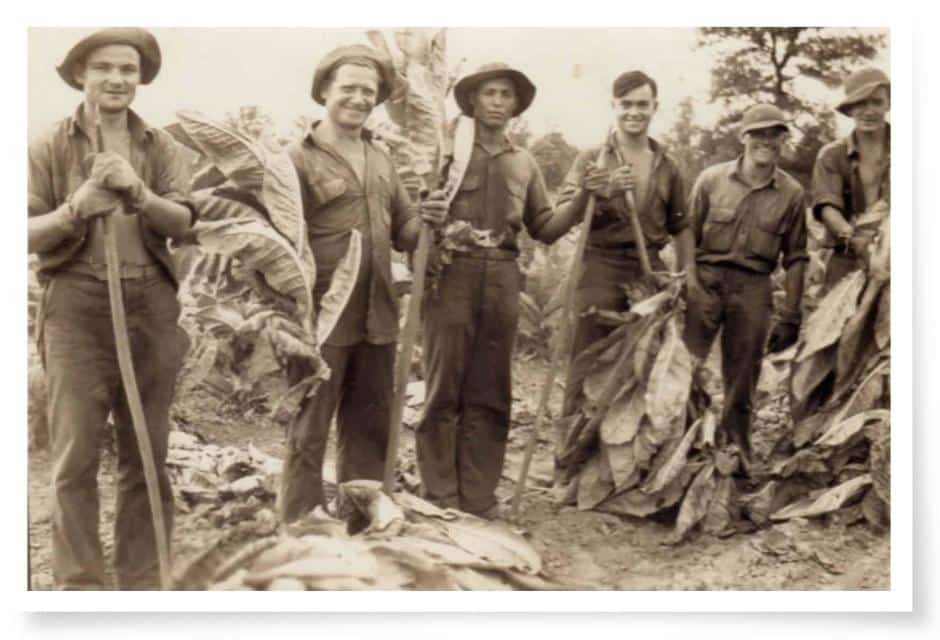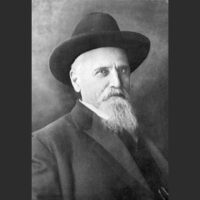Six men stop in a tobacco patch — sticks and spikes in hand. Dressed in matching clothes, they appear more than happy to take a break and to smile broadly for the photographer as he releases his shutter and …
CLICK!
An international moment is captured.

This month’s photograph takes us back into the depths of a tobacco patch and into a little blip of our agricultural history. The men pictured here look like any other farmhands. Suntanned and sweaty, they seem completely natural doing this work in this environment. However, these men are not regular hired hands. They are German prisoners of war being held at Camp Campbell during World War II.
I am admittedly not an expert on this topic. This story was introduced to me early in my days at the museum — simply as a “did you know?” comment. Over the years, I have heard little bits and pieces from people who remember the soldiers on their family farms, but most everyone who is left to remember was just a little kid when the Germans worked their family’s lands. One told me that her earliest memories are of these men — but that she wasn’t allowed out of the house when they were nearby in the yard. Another spoke of the biscuits that her mother would make for the men. We have a few photographs, including this one, in the museum’s artifact collection, but honestly, that’s about it.
Lucky for us, Dr. Antonio Thompson, a history professor at Austin Peay State University, has studied (and continues to study) the men who were held prisoner here during WWII. His book “German Jackboots on Kentucky Bluegrass: Housing German Prisoners of War in Kentucky, 1942-1946” (Diversion Press, 2008) provided me with so much insight and historical reference. Thanks, Dr. Thompson!
Camp Campbell, the predecessor of the permanent installation we know and love as Fort Campbell, operated as a training facility beginning in September 1942. The camp expanded in 1943 to include extensive accommodations to house up to 3,000 German prisoners of war at a time. Three separate POW camps — DD, XO and VW — were established in different parts of the existing installation. Over time, two camps would be designated for anti-Nazi prisoners while the other was relegated to proclaimed Nazis.
Stipulations in the Geneva Convention of 1929 required nations to treat prisoners of war the same as their own soldiers. Prisoners were supposed to receive adequate food, lodging and even recreational opportunities. The POW camps at Camp Campbell even went so far as to print their own newspapers, put together an orchestra and produce full theatrical performances. Some locals complained early on that the prisoners were eating better than regular citizens due to rations in place during the war. Although confined and held captive, these men managed to create a life for themselves in their unintended Kentucky home.
POWs as farm laborers
They ended up on local farms as part of what I can best describe as a work-release program. Farmers could hire prisoners to work in the fields. With the help of the Christian County Farm Bureau and the University of Kentucky Extension Office, farmers applied to the government to receive prisoners as laborers. The POWs were typically in bands of up to 10 men and were always accompanied by an armed guard from the U.S. Army. They were paid $2.50 per day for their labor, and they were only allowed to be away from the camp from 7 a.m. until 5 p.m. As you all know, most farm work, especially during the height of the season, goes well beyond 5 p.m. — often until dark, if not later.
In spite of their shortened hours, the prisoners still filled a huge need for workers. With so many local men fighting in both Europe and the Pacific, farmers were struggling to keep up. These prisoners, our enemies by all intents and purposes, saved our agricultural community during WWII. On Jan. 19, 1945, the Kentucky New Era reported that German POWs spent 20,800 man-hours helping Christian County farmers in 1944. Just think what would have happened without them? Without their work, crops may have been left to rot and die in fields.
Working outside of the camps offered a bit of freedom to the prisoners. Yes, they were always accompanied by a guard, but stories indicate that the guards were often lax when it came to the POWs. If nothing else, it gave them a change of scenery. It also tended to provide them with a good meal, since many of the families frequently gave their young farmhands a hefty lunch just as they would any other workers. Officials complained that the men were provided a meal from the Army and should not receive additional or special treatment.
But let’s face it. We are known for our hospitality around here — especially when it comes to food. And what these farmers and their families saw in these young men were not the faces of an enemy to be fought and hated. They saw the faces of sons, brothers and husbands who were far from home and separated from all they knew. Were they the enemy? In a big way, maybe. But in a personal, individual way, not at all. One could only hope that our own young men would be treated with such humanity, such compassion, in a similar situation.
To me, this story is one of so many that needs to be documented before it is forgotten altogether. In the grand scheme of our community’s history, the three years that German POWs saved our farmers and our tobacco crops could almost be a footnote. But it is so much more! This story connects us, connects Christian County, to the larger American story. It highlights how small the world truly is and how we have played a tiny part in so many of the world’s greater events.
A wise man once told me that everything has a Hopkinsville connection. I’m coming to realize more and more that he is profoundly correct.





